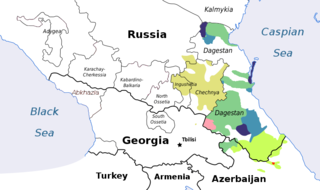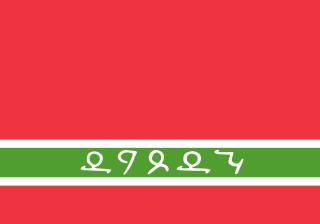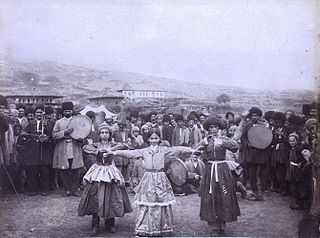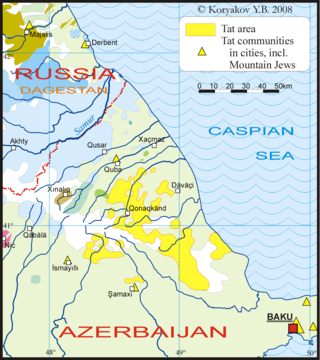
The Northeast Caucasian languages, also called East Caucasian, Nakh-Daghestani or Vainakh-Daghestani, or sometimes Caspian languages, is a family of languages spoken in the Russian republics of Dagestan, Chechnya and Ingushetia and in Northern Azerbaijan as well as in Georgia and diaspora populations in Western Europe and the Middle East. According to Glottolog, there are currently 36 Nakh-Dagestanian languages.
Articles related to the Azerbaijan Republic include:

Lezgins are a Northeast Caucasian ethnic group native predominantly to southern Dagestan, a republic of Russia, and northeastern Azerbaijan, and speak the Lezgin language. Their social structure is firmly based on equality and deference to individuality. Lezgin society is structured around djamaat and has traditionally been egalitarian and organised around many autonomous local clans, called syhils (сихилар).

The Caucasian languages comprise a large and extremely varied array of languages spoken by more than ten million people in and around the Caucasus Mountains, which lie between the Black Sea and the Caspian Sea.

Shirvan is a historical region in the eastern Caucasus, as known in both pre-Islamic Sasanian and Islamic times. Today, the region is an industrially and agriculturally developed part of the Republic of Azerbaijan that stretches between the western shores of the Caspian Sea and the Kura River, centered on the Shirvan Plain.

The Talysh people or Talyshis, Talyshes, Talyshs, Talishis, Talishes, Talishs, Talesh are an Iranian ethnic group, with the majority residing in Azerbaijan and a minority in Iran. They are the indigenous people of the Talish, a region on the western shore of the Caspian Sea shared between Azerbaijan and Iran. The main city of the Talysh people and their homeland is Lankaran, the majority of the population of which is ethnically Talysh. They speak the Talysh language, one of the Northwestern Iranian languages. The majority of Talyshis are Shiite Muslims.

Tat, also known as Caucasian Persian, Tat/Tati Persian, or Caucasian Tat, is a Southwestern Iranian language closely related to, but not fully mutually intelligible with Persian and spoken by the Tats in Azerbaijan and Russia. There is also an Iranian language called Judeo-Tat spoken by Mountain Jews.

Judeo-Tat or Juhuri is a Judeo-Persian dialect of the Tat language historically spoken by the Mountain Jews, primarily in Azerbaijan, Dagestan, and today in Israel. It belongs to the southwestern group of the Iranian division of the Indo-European languages with heavy influence from the Hebrew language. In the era of Soviet historiography, the Mountain Jews were mistakenly considered to be related to the Muslim Tats of Azerbaijan. However, they do not share a common linguistic heritage, as the Mountain Jews kept their native language, while the Muslim Tats eventually adopted Persian. The words Juvuri and Juvuro translate as "Jewish" and "Jews".

The peoples of the Caucasus, or Caucasians, are a diverse group comprising more than 50 ethnic groups throughout the Caucasus.

The Tsakhur or Saxur people are a Lezgin sub-ethnic group of northern Azerbaijan and southern Dagestan (Russia). The group numbers around 30,000 people and are called yiqy, but are generally known by the name Tsakhur, which derives from the name of a Dagestani village, where they make up the majority.
The Azerbaijani people are a Turkic ethnic group of mixed ethnic origins, primarily the indigenous peoples of eastern Transcaucasia, the Medians, an ancient Iranian people, and the Oghuz Turkic tribes that began migrating to Azerbaijan in the 11th century CE. Modern Azerbaijanis are the second most numerous ethnic group among the Turkic peoples after Anatolian Turks and speak North Azerbaijani and/or South Azerbaijani. Both languages also have dialects, with 21 North Azerbaijani dialects and 11 South Azerbaijani dialects.
Azerbaijanis in Russia or Russian Azerbaijanis are people of Azeri descent in Russia. These may be either ethnic Azeris residents in the country or recent immigrants who profess Azeri ancestry.
Tsakhur is a Northeast Caucasian language spoken by the Tsakhurs in northern Azerbaijan and southwestern Dagestan (Russia). It is spoken by about 11,700 people in Azerbaijan and by about 10,600 people in Russia. The word Tsakhur derives from the name of a Dagestani village where speakers of this language make up the majority.

This article focuses on ethnic minorities in the Republic of Azerbaijan.

Khinalug (also spelled Khinalig, Khinalugi, Xinalug(h), Xinaliq or Khinalugh) is a Northeast Caucasian language spoken by about 3,000 people in the villages of Khinalug and Gülüstan, Quba in the mountains of Quba Rayon, northern Azerbaijan. It forms its own independent branch within the Northeast Caucasian language family.
The majority of the population of Iran consists of Iranic peoples. The largest groups in this category include Persians and Kurds, with smaller communities including Gilakis, Mazandaranis, Lurs, Tats, Talysh, and Baloch.
The Intercontinental Dictionary Series is a large database of topical vocabulary lists in various world languages. The general editor of the database is Bernard Comrie of the Max Planck Institute for Evolutionary Anthropology, Leipzig. Mary Ritchie Key of the University of California, Irvine is the founding editor. The database has an especially large selection of indigenous South American languages and Northeast Caucasian languages.
Azerbaijan has had a deliberate policy of forced assimilation of ethnic minorities since Soviet times and up to the present. Non-Turkic peoples, such as Talyshis, Lezgins, Tats and others have been subjected to forced Azerbaijanization (Turkification).













